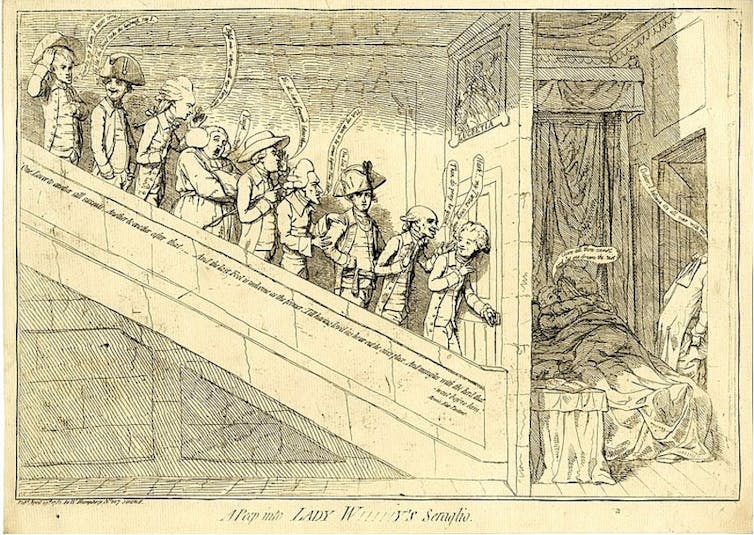Yn 'Slut!' mae Taylor Swift yn dod yn rhan o hen hanes y menywod sy’n ymladd nôl yn eu gwaith yn erbyn cywilyddio menywod ‘pryfoclyd’

Taylor Swift. Llun: © Glenn Francis
09 Tachwedd 2023
Mewn erthygl yn The Conversation, mae Dr Lucy Thompson, Darlithydd ym maes Llên ac Ysgrifennu Creadigol y 19eg ganrif yn egluro bod codi cywilydd ar fenywod pryfoclyd - ‘slut-shaming’ - yn arfer sy’n mynd nôl ganrifoedd, a bod hanes menywod yn taro nôl yn erbyn hyn yn un maith:
One track stands out on the rereleased edition of Taylor Swift’s iconic album, 1989. In Slut!, Swift addresses her encounters with slut-shaming – behaviour that shames women who are judged to be promiscuous. “But if I’m all dressed up,” the singer muses, “they might as well be looking at us. And if they call me a slut, you know it might be worth it for once”.
“Slut-shaming” is a relatively modern phrase – but the behaviour itself has scarcely evolved since the 1700s. Back then, the popular vernacular was rife with terms and phrases aimed at degrading women for their supposed sexual indiscretions, painting them as inherently untrustworthy beings ruled by carnal desires.
Dictionaries of the age marked women who accidentally exposed their breasts in public (“sported blubber”) as well sexually experienced women (“mort wap-apaces”) and “beastly, sluttish women” (“fusty luggs”).
The role of the popular press in slut-shaming is also long-standing. Newspapers in the 1700s gladly printed letters judging women’s behaviour and fashion choices. Men often wrote under crude pseudonyms like “Bumfiddle”, which are not too dissimilar to those chosen by today’s internet trolls. They penned vehement letters about the way women dressed, slut-shaming them as “cork-rumped devils”.
The scandalous Lady W
Stories detailing the supposedly scandalous behaviour of women were regularly featured in newspapers across both urban and rural areas, catering to a societal appetite for salacious content. “Wanton” Lady Seymour Worsley – who was the subject of the 2015 BBC drama The Scandalous Lady W – was a prime target.
In 1782, she drew outrage for her supposedly brazen sexuality. She was shamed for having multiple sexual partners and became the subject of smutty cartoons. James Gillray’s famous caricatures are among of dozens of shaming images that sought to “expose” Lady Worsley. They accompanied a vicious attempt by her husband to destroy her reputation in court.

Lady Worsley’s story shows the long history of slut-shaming. But it also showcases the long history of women fighting back. Instead of bowing to societal shame, Lady Worsley boldly boasted about her reputation in verse.
Her witty poem, An Epistle from L–y W——y to S-r R—–d W—–y (1782), showed that she was unaffected by the public scrutiny and those who tried to slut-shame her. She confirmed she was not “chaste” and didn’t care what the world said about it. She proudly claimed her right to sexual freedom and autonomy – a significant act of defiance in an era that placed immense value on a woman’s chastity and reputation.
During the same period, playwright Sophia Lee electrified audiences with her “licentious” comedy The Chapter of Accidents (1780). It used the word “slut”, but had powerful strategies to support its women characters. Their personal and intimate lives were discussed and criticised by others, but in her story, they weren’t ostracised by society or made to become nuns.
Lee objected to the double standards of the day that allowed men to sleep around while bad-mouthing women for the same actions. As a result, her confident characters may get called “slut” for sleeping with their suitors before marriage, but they’re still granted a happy ever after when they reinvent themselves as eligible virgins at the end of the play.
With the release of Slut!, Swift is mirroring these acts of defiance. Like these women who went before her, Swift, too, has successfully rewritten her public persona by openly challenging sexist social attitudes in her work.
Mae'r erthygl hon wedi ei hailgyhoeddi o The Conversation dan drwydded Creative Commons. Darllenwch yr erthygl wreiddiol.
